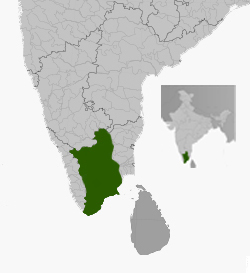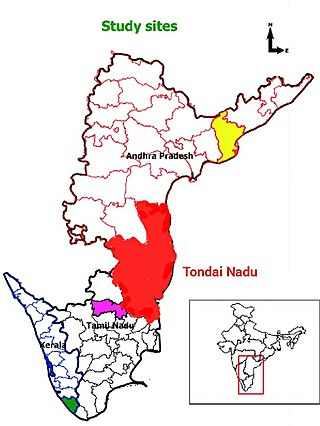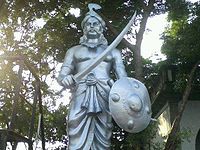
The Kingdom of Travancore, also known as the Kingdom of Thiruvithamkoor, was an Indian kingdom from c. 1729 until 1949. It was ruled by the Travancore Royal Family from Padmanabhapuram, and later Thiruvananthapuram. At its zenith, the kingdom covered most of the south of modern-day Kerala and the southernmost part of modern-day Tamil Nadu with the Thachudaya Kaimal's enclave of Irinjalakuda Koodalmanikyam temple in the neighbouring Kingdom of Cochin. However Tangasseri area of Kollam city and Anchuthengu near Attingal in Thiruvananthapuram were parts of British India. Bordering the kingdom were the five Tamil-majority Taluks of Madras Presidency to the north, Madurai and Tirunelveli districts of Pandya Nadu region in Madras Presidency to the east, the Indian Ocean to the south, and the Arabian Sea to the west. As of the 1911 Census of India, Travancore was divided into five: Padmanabhapuram, Trivandrum, Quilon, Kottayam, and Devikulam, of which the first and last were predominantly Tamil-speaking areas.

The history of southern India covers a span of over four thousand years during which the region saw the rise and fall of a number of dynasties and empires.

Idukki (ഇടുക്കി), IPA: [iɖukːi], is one of the 14 districts in the Indian state of Kerala. Idukki district lies amid the Cardamom Hills of Western Ghats in Kerala. Idukki district contains two municipal towns - Kattappana and Thodupuzha. The district currently includes five taluks in it.

The Pandyan dynasty, also referred to as the Pandyas of Madurai, was an ancient Tamil dynasty of South India, and among the four great kingdoms of Tamilakam, the other three being the Pallavas, the Cholas and the Cheras. Existing since at least the 4th to 3rd centuries BCE, the dynasty passed through two periods of imperial dominance, the 6th to 10th centuries CE, and under the 'Later Pandyas'. Under Jatavarman Sundara Pandyan I and Maravarman Kulasekara Pandyan I, the Pandyas ruled extensive territories including regions of present-day South India and northern Sri Lanka through vassal states subject to Madurai.

Pandya Nadu or Pandi Nadu is a geographical region comprising the southern part of the present day state of Tamil Nadu. The region is bounded on its West by the Venad/Ay Nadu, Northeast by the Chola Nadu and Northwest by the Kongu Nadu. It comprises the present-day districts of Madurai, Theni, Sivaganga, Ramanathapuram, Virudhunagar, Tirunelveli, Tenkasi, Thoothukudi, Kanniyakumari, parts of Pudukkottai and Dindigul.

Kanniyakumari district is one of the 38 districts of Tamil Nadu state and the southernmost district in mainland India. It stands second in terms of population density among the districts of Tamil Nadu. It is also the richest district in Tamil Nadu in terms of per capita income, and also tops the state in Human Development Index (HDI), literacy, and education. The district's headquarters is Nagercoil.

Kolattunādu (Kola Swarupam, as Kingdom of Cannanore in foreign accounts, Chirakkal (Chericul) in later times) was one of the four most powerful kingdoms on the Malabar Coast during the arrival of the Portuguese Armadas in India, along with Zamorin, the Kingdom of Cochin and Quilon. Kolattunādu had its capital at Ezhimala and was ruled by the Kolattiri royal family and roughly comprised the North Malabar region of Kerala state in India. Traditionally, Kolattunādu is described as the land lying between the Chandragiri river in the north and the Korappuzha river in the south. The Kolathunadu (Kannur) Kingdom at the peak of its power, reportedly extended from the Netravati River (Mangalore) in the north to Korapuzha (Kozhikode) in the south with the Arabian Sea on the west and Kodagu hills on the eastern boundary, also including the isolated islands of Lakshadweep in the Arabian Sea.

The region of Tamil Nadu in the southeast of modern India, shows evidence of having had continuous human habitation from 15,000 BCE to 10,000 BCE. Throughout its history, spanning the early Upper Paleolithic age to modern times, this region has coexisted with various external cultures.

Chandrabhanu or Chandrabhanu Sridhamaraja was the King of Tambralinga Kingdom in present-day Thailand, Malaysia and Sumatra and the Jaffna Kingdom in northern Sri Lanka. A Javaka, he was known to have ruled from during the period of 1230 until 1262. He was also known for building a well-known Buddhist stupa in southern Thailand. He spent more than 30 years in his attempt to conquer Sri Lanka. He was eventually defeated by the forces of the Pandyan Dynasty from Tamil Nadu in 1262 and was killed by the brother of the south Indian Emperor Jatavarman Sundara Pandyan.

Muhammad Yusuf Khan was a commandant of the British East India Company's Madras Army. He was born in a Tamil Vellalar caste family in a village called Panaiyur in British India, what is now in Nainarkoil Taluk, Ramanathapuram District of Tamil Nadu, India. He converted to Islam and was named Muhammad Yusuf Khan. He was popularly known as Khan Sahib when he became a ruler of Madurai. He became a warrior in the Arcot troops, and later a commandant for the British East India Company troops. The British and the Arcot Nawab employed him to suppress the Polygar uprising in South India. Later he was entrusted to administer the Madurai country when the Madurai Nayak rule ended.
Agastheeswaram is a panchayat town in Kanniyakumari district in the Indian state of Tamil Nadu.
Sivagiri is a panchayat town and a tourist place in Tenkasi district in the Indian state of Tamil Nadu. Sivagiri is located at a distance of 50 km north to Tenkasi, 20 km south to Rajapalayam, 95 km north-west to Tirunelveli, 95 km south to Madurai, 540 km south to Bangalore, 150 km north to Thiruvananthapuram and 580 km south to the state capital Chennai.

Ay was one of the Tamil dynasties which controlled the south-western tip of the peninsula, from the early historic period up to the medieval period.The clan traditionally held sway over the harbour of Vizhinjam, the fertile region of Nanjinad, and southern parts of the spice-producing Western Ghat mountains. The dynasty was also known as Kupaka in medieval period.

The Madurai Nayaks were a Telugu dynasty who ruled most of modern-day Tamil Nadu, India, with Madurai as their capital. The Nayak reign which lasted for over two centuries from around 1529 to 1736 was noted for its achievements in arts, cultural and administrative reforms, revitalization of temples previously ransacked by the Delhi Sultans, and the inauguration of a unique architectural style.

Palaiyakkarars, or Poligar, in Andhra and Tamil Nadu refers to the holder of a small kingdom as a feudatory to a greater sovereign. Under this system, palayam was given for valuable military services rendered by any individual. The word pālayam means domain, a military camp, or a small kingdom. This type of Palayakkarars system was in practice during the rule of Pratapa Rudhra of Warangal in the Kakatiya kingdom. The system was put in place in Tamilnadu by Viswanatha Nayaka, when he became the Nayak ruler of Madurai in 1529, with the support of his minister Ariyanathar. Traditionally there were supposed to be 72 Palayakkarars. The majority of those Palaiyakkarar, who during the late 17th- and 18th-centuries controlled much of the Telugu region as well as the Tamil area, had themselves come from the Kallar, Maravar and Vatuka, pala ekari communities.

The Early Pandyas of the Sangam period were one of the three main kingdoms of the ancient Tamil country, the other two being the Cholas, and Cheras Dynasty. As with many other kingdoms around this period, most of the information about the Early Pandyas come to modern historians mainly through literary sources and some epigraphic, archaeological and numismatic evidence. The capital of the Early Pandyan kingdom was initially Korkai, Thoothukudi and was later moved to Koodal during the reign of Nedunjeliyan I. The kingdom lay to the south of the Maurya Empire of India.
Devarattam is a Tamil Word derived from the words "Devar" or Thevar and "Attam". Traditionally, it was performed by the kings and warriors after a successful battle particularly in pandyan dynasty, Later it was danced by the some group of peoples of Maravar clan belongs to mukkulathor community who is refereed as Devar in present Madurai and nearby regions believe they are related to the Pandya dynasty, parallelly devarattam was also performed by the kings and warriors of the chola dynasty in ancient days as a joy of victory, still it was followed by some group of peoples of Kallar clan belongs to mukkulathor community who claim descent from the Chola dynasty and also refereed as Devar in present Thanjavur and nearby regions of south-east Tamil Nadu, After the fall of both chola and pandya dynasties both clans not celebrates the joy of victory by devarattam. In the period following Indian independence, devarattam is performed mostly by the Rajakambalathu Nayakkar a Telugu origin community those believes they are migrants from Andhra Pradesh Vijayanagar dynasty of South India and settled in Tamil Nadu for many generations and upkeep Tamil traditions and religious practices also socially friendship with Mukkulathor Devar as well as all communities of Tamil Nadu, at present devarattam was mostly performed only by the professional dancers of the same community during the temple festivals and other functions in Tamil Nadu
When to date the start of the history of the Jaffna kingdom is debated among historians.

Tondaimandalam, also known as Tondai Nadu, is a historical region located in the northernmost part of Tamil Nadu and southernmost part of Andhra Pradesh. The region comprises the districts which formed a part of the legendary kingdom of Athondai Chakravarti. The boundaries of Tondaimandalam are ambiguous – between the river basins of Penna River and Ponnaiyar River. During the reign of Rajaraja I, this region was called as Jayankonda Cholamandalam.

The Pandyan empire is believed to have first emerged circa 600 BC and was one of the leading Tamil dynasties of Southern India. There were various forms of art and many architectural communities within the empire, and their work was sold to overseas markets. Rock cutting and structural temples are examples of these, playing a significant role in Pandyan culture. The rock carvings typically depicted religious figures, floral motifs and animals and were made to surround temples and shrines.
















